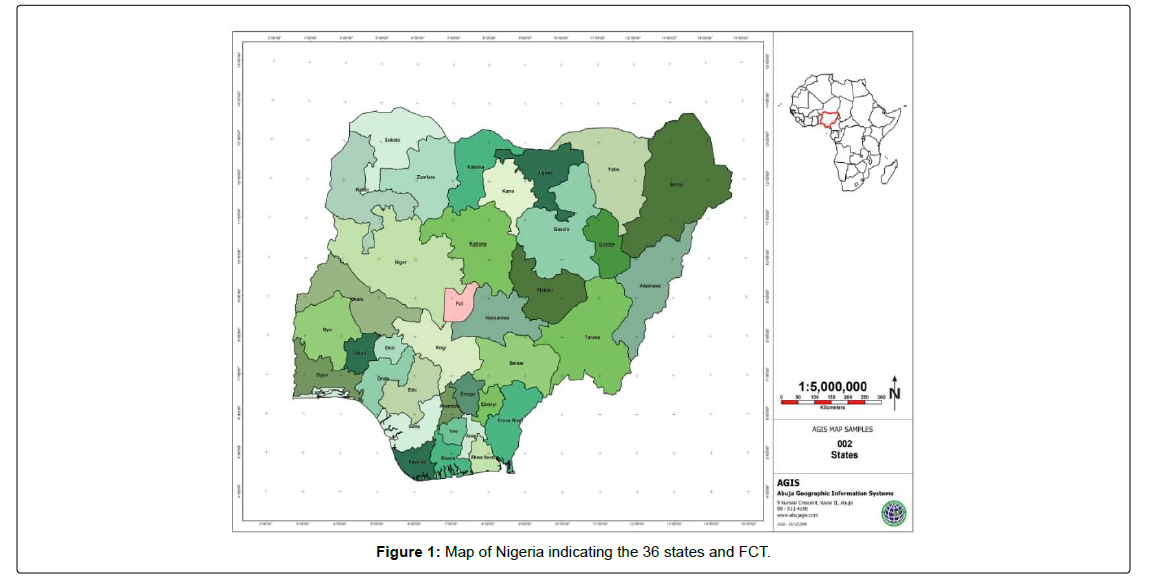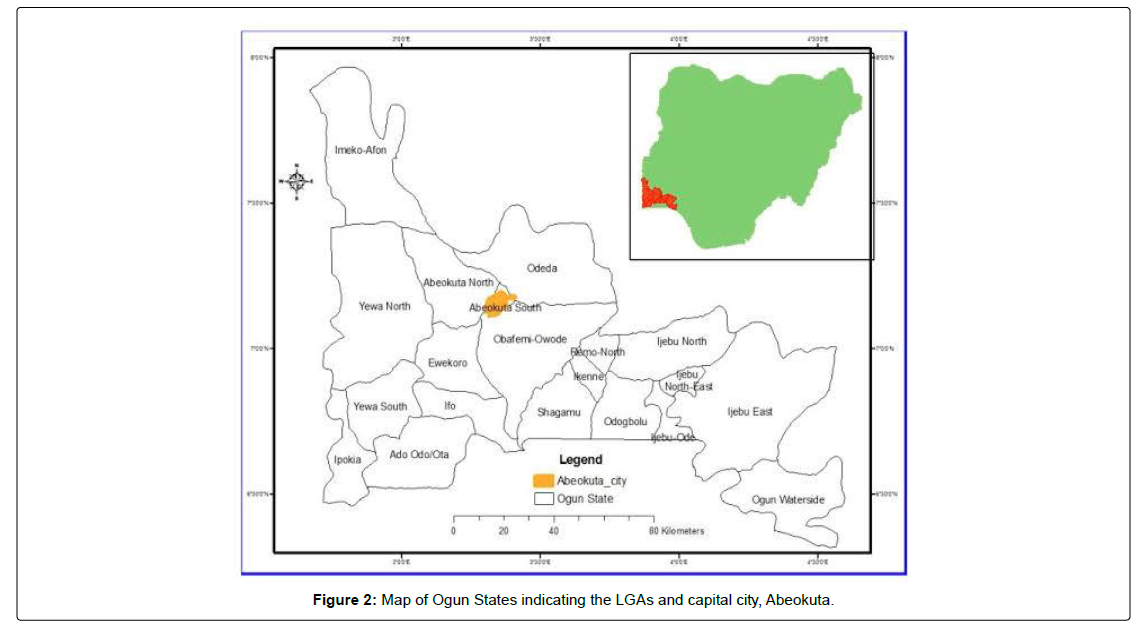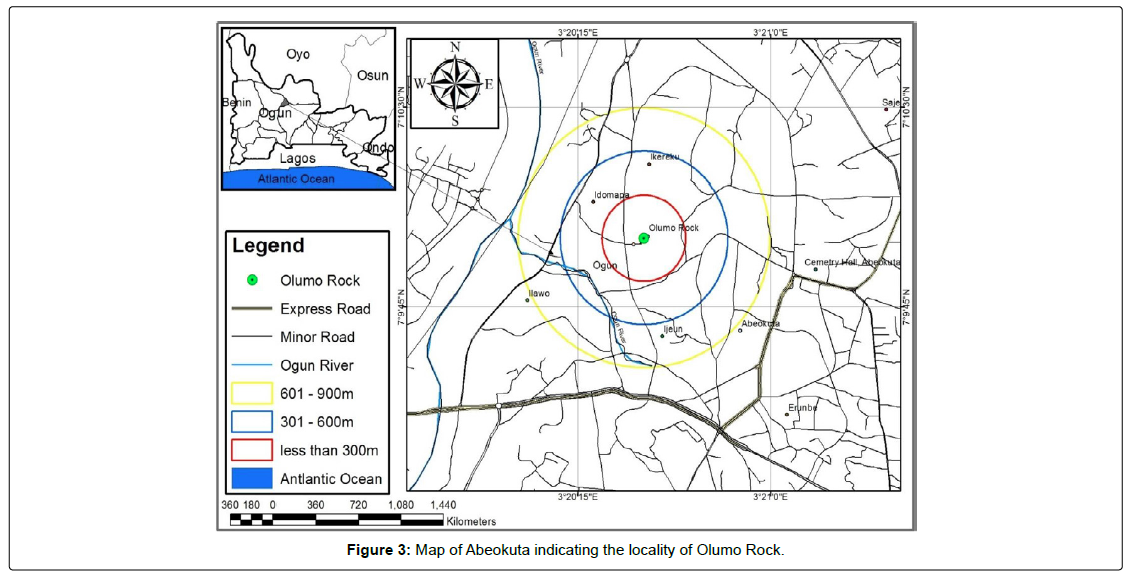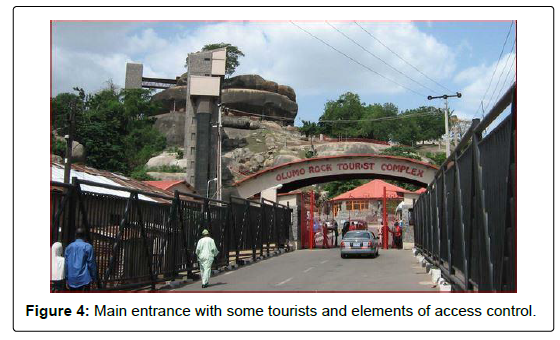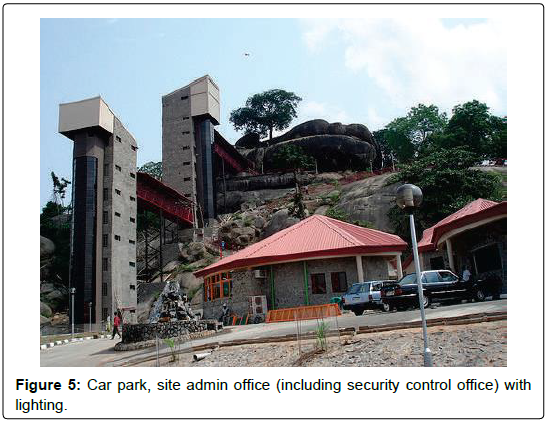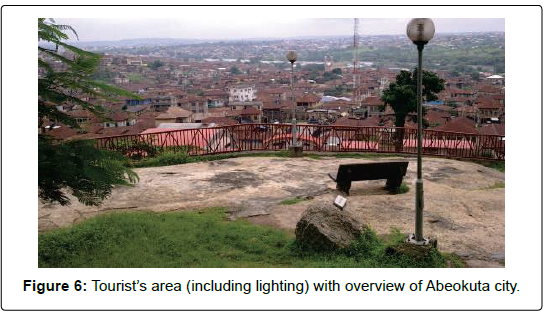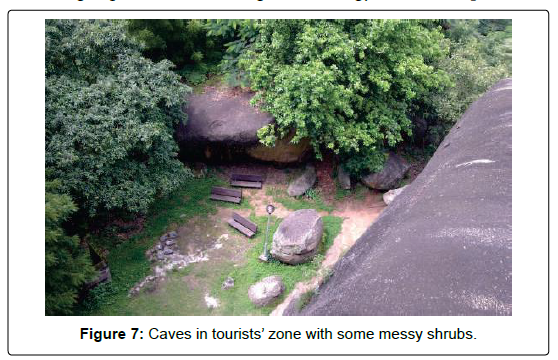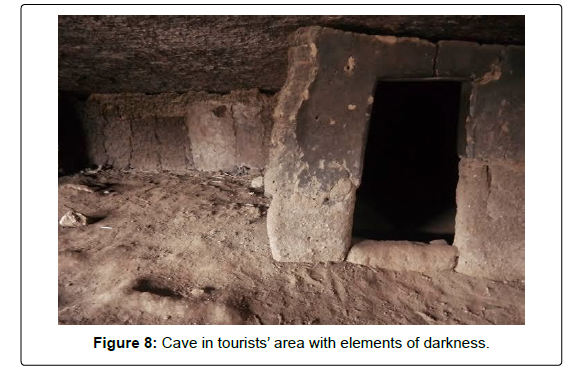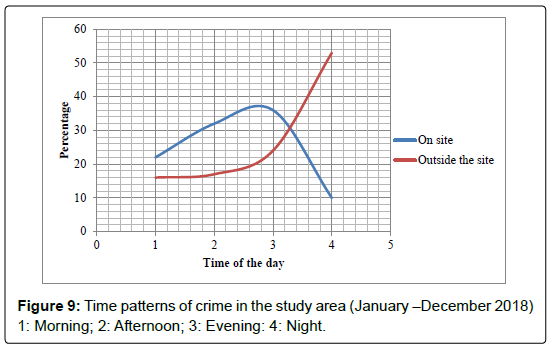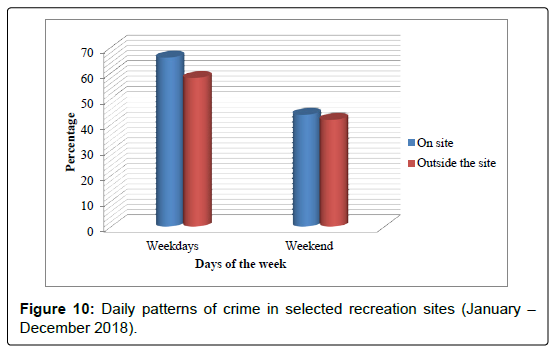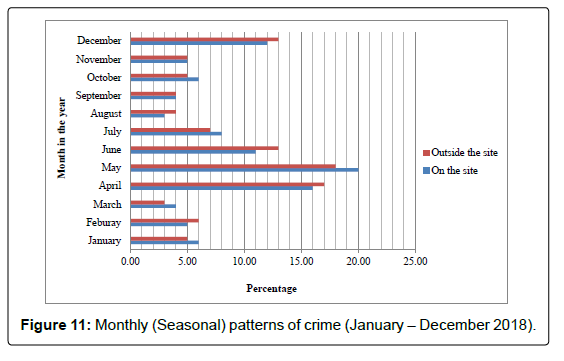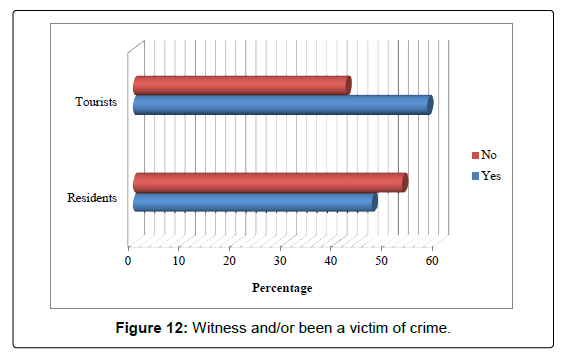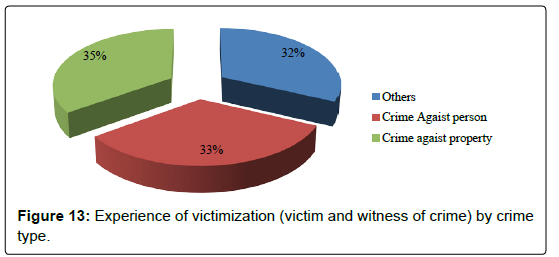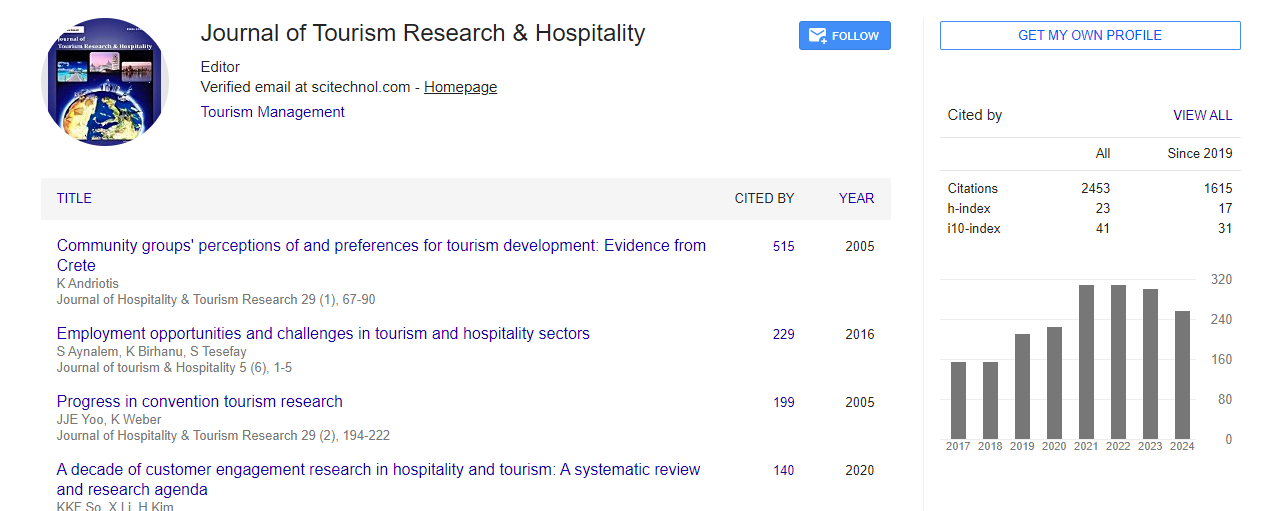Research Article, J Tourism Res Hospitality Vol: 10 Issue: 7
Evaluating Crime and Environmental Design of a Tourist’s Attraction Site in Nigeria.
Adewumi I Badiora1*, Olanrewaju T Dada1, Bashir O Odufuwa1 and Temitope M Adebara2
1Department of Urban and Regional Planning, Olabisi Onabanjo University Ago-Iwoye, Ogun State, Nigeria
2Department of Urban and Regional Planning, Obafemi Awolowo University Ile-Ife, Nigeria
- *Corresponding Author:
- Adewumi I Badiora
Department of Urban and Regional Planning, Olabisi Onabanjo University Ago-Iwoye, Ogun State, Nigeria
Tel: +2348037825891
E-mail: wumibadiora@gmail.com
Received Date: May 03, 2019; Accepted Date: July 23, 2021; Published Date: July 30, 2021
Citation: Badiora AI, Dada OT, Odufuwa BO, Adebara TM (2021) Evaluating Crime and Environmental Design of a Tourist’s Attraction Site in Nigeria. J Tourism Res Hospitality 10:7.
Copyright: © All articles published in Dental Health: Current Research are the property of SciTechnol, and is protected by copyright laws. “Copyright © 2021, SciTechnol, All Rights Reserved.
Keywords: Crime pattern; Tourist’s site; CPTED; Routine activity theory; Olumo rock
Abstract
This study examines pattern of crime and determines whether a tourist’s site meet safety standards according to crime prevention through environmental design [CPTED]. It also identifies the elements of environmental design that affect crime at a Nigerian tourist’s site. The study process consisted of two steps: the on-site assessment of CPTED and an appraisal of crime events over a period of time. Both primary and secondary data were collected and explored using percentages, Chi-square and correlation. Findings confirm CPTED applications (including surveillance, access control, territoriality, activity support and image-maintenance) on the site. Nevertheless, different places in the study area are not so designed to meet CPTED standards. Results support the notion of crime concentration as postulated by routine activity theory. Moreover, significant relations are observed for surveillance and theft; access control and robbery, fights, vandalism and theft; territoriality and robbery as well as fights and vandalism; activity support and theft. The study concludes that there is still much to be done regarding environmental design elements of the site so as to lessen prospects for crime events. Recommendations and future research implications are discussed.Keywords
Crime pattern; Tourist’s site; CPTED; Routine activity theory; Olumo rock.
Introduction
Nigeria is presently going through an exasperating time with all form of insecurity challenges such as kidnapping, homicide, robbery, revolts, bombing, drug and human trafficking, illegal immigration, cultism, gang violence, and other forms of mayhem. The country is equally believed to be home to a substantial network of organized crime [1]. This is not to say however, that all places in Nigeria are home to such happenings or that this criminal behavior takes place often time in the country. Rather, what can be said is that some of the crime events are blown up by mass media. While many crime happenings are undeniable, the approach taken to convey news by some media can, at times, seem distrustful, misleading or even as if it is part of an opposition politicking set out to intimidate foreign attractions or negatively affect the disposition of people governing the country. The consequences that such media amplifications have on potential travel to a tourist’s destinations can be intense; leaving them to ask the question “is this place safe enough to visit?”
Undeniably, explicit within concepts of safety are the daily interactions occurring between people and environmental design of a place. As Boakye [2] and George [3] have referred to in their work, the way in which tourists perceive the design of the destination environment (and resulting interactions occurring at the destination) may serve to explain how safe the tourists feels while visiting. To date, however, a dearth of research exists on how environmental design of tourist’s sites shapes crime events within and around destinations in sub-Saharan Africa, particularly Nigeria. There is no doubt that studies in Nigeria have identified socio-economic variables as motivations for crime at tourist’s destination sites. For instance, Omisore, Badiora and Fadoyin [4] examine crime incidence on tourists and find out that the rates of victimization differ significantly as reflected by the socioeconomic characteristics of the tourists. Similar findings have been found elsewhere [5-8]. These studies failed to examine environmental design of tourist’s destination site as it affects crime. Few studies which have highlighted the importance of environmental design in tourist’s destinations [9-11] are trial and perception surveys mostly carried out in western countries. Hitherto, there is paucity of research that is designed to measure crime and make clear the importance of CPTED in explaining crime occasions with an on-site study conducted in a sub-Saharan tourist’s destination; particularly in Nigeria
CPTED supports and develops great ideas on crime prevention through urban planning and design [12-14]. The process of designing security into urban planning and architecture is known as CPTED, and it is based on the proposition that the appropriate design and application of the built and surrounding environment can improve the quality of life by deterring crime [13]. According to Ekblom [15], CPTED is more than traditional security tools in urban planning such as building of fences, walls, installing of alarms, as well as police officers and guards on the streets. However, CPTED focuses more on natural security strategies, such as natural surveillance, access control, territorial reinforcement, maintenance and activity support. CPTED is often used to repair public places that suffer from crime. For example, governments in Nigeria have carried out regeneration projects to improve the physical environment of tourist’s places. Since most public places in Nigeria suffer insecurity problems [16], physical restoration usually incorporate CPTED to reduce crime and, thus, improve social sustainability for users. However, the effectiveness and efficiency of CPTED implementation in public places is still disputed.
Although many studies have assessed CPTED, most recent previous studies have evaluated this at the neighborhood level [17-18], recreation centres [19-20], business and shopping centers [21-23], and transport places [24-31]. CPTED measures are used in different places within a tourist’s sites as well and this call for assessment. Additionally, no study has done on- the- site assessment according to CPTED strategies in a tourist’s destination site. Therefore, this study is aimed to analyze how CPTED measures such as access control, closed-circuit television (CCTV), lighting, activity support and maintenance among others, influenced crime by objectively assessing CPTED approaches and crime at a travel location level in Nigeria. Accordingly, this study provides answers to the following question: Does the tourist’s site meet reasonable security standards according to CPTED strategies? What are the types, characteristics and pattern of crime on and around the tourist’s site? What elements of an environmental design (according to CPTED approaches) affect crime in the study area?
To attain this aim and answer these questions, this study is divided into phases. First is the on site assessment regarding CPTED practices on the site. For this, the survey is designed based on the literature and international CPTED audit and site assessment specifications. The survey questionnaire is divided into five blocks of CPTED strategies: surveillance; access control (and target hardening); territoriality (territorial reinforcement); image management (maintenance) and activity support. In the survey, many questions are designed to assess elements of landscape (trees, bushes, and others) and surrounding environment (fences, gates, pathways and others), as well as lighting (brightness, color, illumination, height of pole, lighting at different site areas and elements and others). Second is on a statement of objective insecurity identified in the study area from January to December 2018. The last phase is on identification of factors of environmental design (CPTED) that affect crime and safety on the site.
This study will provide insights into crime and safety patterns as well as effective use of CPTED strategies with a view to achieving safe tourist’s locations that would encourage holidaymakers. Through this research, it is hoped that findings will provide further input towards enhancing the physical and environmental design aspects of the tourist’s destination site. In addition to providing an outlook of Nigeria regarding the crime and safety in an international tourist’s site, this study is also helpful in contributing to academic literature on the less considered area of leisure industry in sub-Saharan Africa; criminology in tourism planning. The rest of this article consists previous studies regarding crime, safety and design of tourist’s site; study’s survey methods and the findings. The paper concludes with recommendations for tourist’s destinations planning and design as well as suggestions for future research directions.
Literature Review
Consistent in literature is the notion that there is a high risk of crime victimization for holidaymakers and those away from home [32- 33]. This was explained by Ryan [34] using five possible interactions. These are that; the victim being a tourist is incidental; the criminal selects a tourist’s site but not necessarily a tourist as the target; the criminal chooses tourists because they are easy targets; crime arises in tourist’s sites to fulfill a demand of the tourists (e.g. prostitution, drug dealings among others); and some crimes are organized specifically on tourists, probably to make a political statement and negotiations (e.g. terrorism and kidnapping). Ryan [34] concludes that tourism is often the provider of victims. Tourists comprise suitable targets to be attacked either by tourists or local residents and incidental victimization only occurs when a tourist’s destination site is newly established. As time passes, crime and the targeting of victims, becomes more purposeful, and tourists come to be selected as targets because of their specific suitability.
Researches have explored the reasons for the relatively high crime in tourist’s areas. Brantingham and Brantingham [35] discuss the nature of tourist’s destination attracting large numbers of people including offenders and victims as one of the main reason for for the quite high crime in tourist’s areas. In similar view, Cohen [36] explains that crime is affected by the very nature of tourism since a large number of foreigners are staying in relatively informal unstructured situations. Tourist’s sites also tend to attract events associated with certain crimes such as drinking, drug and alcohol and associated anti-social behaviour. Tourist’s site possesses many characteristics that make them progressively become dangerous places and scholars have debated various features and how this relates to higher risks of victimization. For instance, Mathieson and Wall [37], Pearce [38]; Ryan [39,34]; Mawby [33,40] argued that the attraction of large numbers of tourists for short periods, transitory populations of tourists and personnel, high levels of anonymity, high spending, and the open accessibility of the area as tourism culture that heighten risk of victimization.
Holidaymakers are easily identifiable as strangers from obvious signs of wealth and sightseeing [41]. For instance, they do not speak the local language; they are seen with large amounts of money; they use maps or ask directions; and they appear less confident in their surroundings [34]. When unfamiliar with an environment, a person’s fear is increased and they feel less secure and emotionally stable, which could well be evident in their non-verbal behaviour [42]. To the offender, a stranger may therefore be very conspicuous and recognized as ‘out-of-place’, especially if the criminal is within his well-known space. Some tourist’s sites are more vulnerable to crime than others [43] particularly, those with high tourist’s inflow [6,38] and where social disorganization and classification is more pronounced [3,44]. To this end, the above studies suggest that tourist’s destinations are risky environment and holidaymakers are more vulnerable to being victims of crime victimization as a result of dynamic interactions among large number of people (which may include criminals and targets), facilitated by the nature of the geographical location of the tourist’s site.
All situations illustrated above could be explained by a number of theories. However in this study, five mutually supportive theories are discussed. These are rational choice, routine activity theory, crime pattern theory, social disorganization theory and, problem analysis triangle. According to many scholars in crime analysis, rational choice (RC) theory is perhaps the most common reason why criminals do the things they do. RC focuses on offenders and suggests that the offender is completely rational when making the decision to commit a crime [45]. The rational choice theory addresses the question as to why criminals commit offences in some situations and not in others. Its main assumption is that offending is purposive behavior, designed to benefit the offender in some way. Rational Choice (RC) therefore suggests that offenders choose targets and define means to achieve their goals in a manner that can be explained [46]. Thus, RC provides the basic underlying principle for defining a particular place (such as tourist’s site) as criminogenic.
Accordingly, Social Disorganization Theory (SDT) can contribute to understanding the links between risky facilities (e.g. tourist’s sites) in a broader geographical context. The SDT relies on the idea that crime occurs when the mechanisms of social control are weak [47]. Crime in public places is directly related with levels of social disorganization [48] or collective efficacy [49]. Researchers have long pointed out that tourism parks have problems similar to those of city centers [19]. One reason is that they may be located in places that have a disproportionate number of opportunities. Another reason is that, as with city centres, majority of tourist’s sites also have liquor sales points, cinemas, among others which generate activities that reproduce problems, associated with the city center. However, regardless if a tourism facility ‘serves’ as a crime generator or attractor [50], studies so far say little about whether and how the internal and external design of the physical and social environments of these facilities influence crime and safety. It should be noted that usually crime generators are particular areas (hot spot) to which large numbers of people are attracted for reasons unrelated to any particular level of criminal motivation they might have or to any particular crime they might commit [51]. Examples include tourism or leisure areas while crime attractors are particular places to which motivated offenders are attracted due to the known opportunities for specific types of crime. Examples might include bars, night clubs and restaurant areas.
Routine Activity (RA) seeks to explain crime occurrence as the coming together of a number of situations [52,53]. These situations include a motivated offender, a desirable target and absence of capable control in place and time. The approach took the likely offender as given and focused on the other elements. The guardian here was not usually a police officer or security agent but rather anybody whose presence or proximity would either prevent or discourage a crime from happening. Thus, Felson [54] suggests that multiple actors exercise social control. There are handlers who control potential offenders and managers who control places and guardians who control targets. Furthermore, there could be two types of guardians in a recreation center: formal and informal guardians. Former guardian includes police officers and security guards while informal guardians include employees or other patrons.
It is suggested that at tourist’s destination, these critical elements are particularly significant owing to the nature of the tourism environment. For instance, tourist’s sites are characterized by a diverse population that enhances opportunities for a potential criminal. Also, the transitory nature of users, accompanied by this freedom of entry and exit provides many opportunities for a potential criminal and facilitates a lack of guardianship. A tourist’s destination site, therefore, brings together large amounts of people simultaneously. Those people can be composed in a couple of different ways. First, people could be composed of all suitable targets. These targets travel to where offenders can victimize them. Secondly, tourists can be composed of both suitable targets and potential offenders. This development is most likely at peak times when the tourist population is at its highest. Although capable guardians are indeed present within these groups identified above, we would argue, however, that at least, one of potential victims and offenders is always present, but a guardian needs not be but does exist, nonetheless. It should be noted that the tourists do not all shares the same journey’s end; hence, they will disperse eventually. So, the capable guardians amongst the tourists get filtered out. As the group of tourists separates, the probability that capable guardians would hinder crime shrinks, simply because of their decreased presence.
The Problem Analysis Triangle (PAT) is a useful framework derived from the RC, RA and SDT perspectives. PAT upholds the principles that any crime requires a victim, an offender and a location (or disorganized environment) that makes it possible. But, a crime can be averted by eliminating or adapting one of these key elements [14]. For instance, if a location (or disorganized environment) was adopted or controlled, the opportunity for crime to occur would be reduced. Hence, environmental design is one of the relatively common approaches used to shape crime and perception of safety in the risky facilities such as tourist’s sites. Supporting PAT perspective, Odufuwa et al. [20] posit that building types, architectural designs and features influence what occurs in them and in their immediate environments. This is because the social interactions that these environments encourage (or attract) at a particular spot are fundamental in turning these facilities from safe to unsafe [55]. These ideologies stimulate what is known as Crime Prevention through Environmental Design [56-58].
Jeffery [12] first used the catchphrase “crime prevention through environmental design”, but Jacobs’s 1961 classic (The Death and Life of Great American Cities) significantly influenced the CPTED idea. CPTED (pronounced as ‘septed’) is defined as “the proper design and effective use of the built environment which can lead to a reduction in the fear of crime and the incidence of crime, and to an improvement in the quality of life.” [59] This implies that environments can be planned in a way that reduces the possibility of crime occurring, by stimulating surveillance, fostering territoriality and reducing areas of conflict by controlling access and improving overall perceived safety. Originally, CPTED focuses on seven key concepts [60]. These are territoriality, surveillance, image management and activity support. Others are access control, target hardening and wider environment. Although the construct continues to evolve, modern CPTED can be defined by the following concepts: surveillance, territoriality, access control, activity support, and image maintenance. These five concepts are interrelated, forming the mainstay of modern CPTED approaches, which are implemented through a variety of design measures.
Territoriality refers to designing spaces in a way that provides a sense of ownership and proprietary concern by users so that they potentially are more likely to act as guardians [30-61]. According to this concept, a place with a close-knit social network can develop voluntary community guardianship. A place that is continuously controlled by its own users, who share a sense of community, can be more effective than police enforcement. Access control is related to the ease of access to the areas [62,63]. It is related to territoriality in that it helps define private and public space and controls who enters a specific site and can include card entry systems, bollards, fencing, and walls [13,56]. Surveillance is the ability to observe what happens in the area or around the immediate environment. It is linked to how visible the site is to neighbors and users [63,64]. It can be promoted or hindered by environmental design and can influence crime and the perceptions of safety of those using such space. The use of good lighting, closed circuit television (CCTV) and security guards are means of promoting the opportunities for surveillance [65].
Target hardening focuses on making crime more difficult by limiting opportunities for crime. It includes using stronger doors and windows and more efficient locks and alarms and seeks to harden targets by increasing the effort required to commit a crime [61]. Activity support involves attracting legitimate activities into areas that are perceived as safe. This is achieved through the thoughtful design of spaces and the use of local events, functions, and other land uses to attract legitimate users. It is argued that with higher levels of “eyes on the street,” criminals potentially are less likely to offend since they may have increased risks of being seen and potentially apprehended [13]. The concept of image maintenance could be traced to Zimbardo’s 1969 social experiment and Wilson and Kelling’s broken window theory [66,67]. In Zimbardo’s experiment [67] deliberately damaged vehicles were abandoned on highways to experiment how they were vandalized. In unmaintained surroundings with no signs of ownership, vandalism and other crime heightened. Thus, to prevent crime, both streets and properties should be maintained so that an image of civility would be perceived by a potential offender. Furthermore, Perkins et al. [68] and Abdullah, et al. [69] found that physical incivilities, particularly “the actual presence of disorder-related cues”, negatively influenced the perception of crime-related problems. Wider environment refers to the influence that nearby land uses and activities may have on the safety and security of a particular site [70]. This particularly relates to land uses that have the tendency to generate crime, such as alcohol outlets, night clubs, bars and cafeterias, hotels, vacant lots/buildings, and cash converters outlet [71].
This study therefore surveys pattern of crime and carries out on-the-site assessment according to CPTED strategies to determine whether tourist’s destination sites in Nigeria meet a reasonable safety ideals. It also identifies the elements of an urban environment (according to crime prevention through environmental design [CPTED] approaches) that affect crime at Olumo international tourist attraction site, Abeokuta, Ogun State, Nigeria.
Study Area
The study adopted a case study method. The site is located in Nigeria; a country situated in the West of Africa (See Figure 1), precisely on latitudes 4o to 14o North and between longitudes 2o 2’ and 14o 30’ East. It has a total area of 923,768 km2 making it the world’s 32nd-largest country in the World. To the north, Nigeria is bounded by the Niger Republic and Chad; in the West by the Benin Republic, in the East by the Cameroon Republic and to the South by the Atlantic Ocean. With over 170 million people, the nation is the most populated Black Country in the World. Nearly half of Nigerians live in cities. Nigeria is extremely diverse in term of culture, with more than 500 ethnic groups. Of the ethnic groups, the principal are the Hausa-Fulani, Yoruba, and Igbo, who comprise majorities in the northern, western, and eastern regions respectively. The population is almost evenly split between Christians and Muslims, with less than two percent adhering to other religions.
Nigeria has witnessed a violent history since achieving independence from the United Kingdom, in October 1, 1960 with civil war breaking out in 1967 and succession of military coups that began shortly after independence and officially ended with the reestablishment of democracy 1999. Nevertheless, Nigeria has remained more insecure especially during and after the April 2011 general election. A number of lawless events that could subject residents and visitors to crime victimization have been pervasive ranging from armed robbers, theft and cross-border crime and homicides, kidnapping and killings. Besides, the country has suffered more than ever, a series of ethnic, religious and political crises. At the international for a Nigeria is one of the countries with heighten national security challenge. The insecurity crisis facing Nigeria is not the only rising incidence but also the gradual shift in the categories of crimes committed [72]. In actual fact, the spectra of crime in Nigerian urban centers has grown that it has remained a dominant feature in national and international debate.
The consequences of the insecurity had been colossal. Many activities by foreign oil extraction and processing workers who convert to tourists during their free time had been put on hold. Many other prospective tourists also fled for safety. The insecurity also resulted into the cancellation of planned visits to Nigeria by many prospective tourists. As Altindag [73] and Holcomb [74] observe, these crime incidences can create dislike among the tourists towards the destination and their entire experience. The prevalence of crime can, thus, buttress tourists’ aversion of a certain destination and, in extreme cases; it can also reinforce their decisions against any future excursions [74]. But given that not all areas and places in Nigeria experience insecurity and the fact that some locations are relative stable in terms of the rate and complexity of crime, the acknowledgement of a confident pictures to tourists’ travel decisions cannot be overlooked. As Michalko [75] cautions, it is imperative to analyze a generalized picture of public safety in terms of tourists’ vulnerability to crime since the internal structure of crime varies within countries and from one country to another.
It is important to note that tourism is relatively a promising business in Nigeria. Tourism could be one of the main sources of economic development in Nigeria. Ajadi [76] observed that Nigeria has great geographical and climate diversity, from the Atlantic Ocean in the South through the Middle Belt region to the far North. In fact, due to Nigeria geographical location and situation, the country has good potentials in ecotourism and marine tourism in attractive shores. Nigeria is blessed with warm, sundry climate, over 800 kilometers of fascinating beaches and evergreen vegetation in the South, while in the North, alluring landforms overshadows savannah grasslands. Added to these are the interesting natural features in form of waterfalls, springs, hills, some mountainous areas with temperate like climate and a range of special and common species of tropical wildlife. These, coupled with wide market opportunities, diverse sociocultural heritage that gives the nation its uniqueness and the hospitality of over 180 million people earn Nigeria the label, Giant of Africa and the most populous Black nation. It is almost impossible to deny Nigeria its pride of place amongst the richly endowed potential tourist destinations in the world. These tourist destinations are found across states in the country. One of these internationally recognized tourist’s attraction sites can be found in Ogun State, Nigeria.
Ogun state is one of the thirty-six (36) states that constitute the Federal Republic of Nigeria, and it is located in the south‐western part of the country (Figure 2). It has a total land area of 16981.26 square kilometers lying between latitude 6.2°N and 7.8°N and longitude 3.00E and 5.0°E. The state is bordered to the east by Ondo State, in the North by Oyo and Osun States and in the south by Lagos State and the Atlantic Ocean and in the west by Republic of Benin. Ogun state consists of mainly Yoruba with several dialects such as the Egbas, the Ijebus and the Remos. Important towns in the state are Abeokuta, Ijebu-Ode, Ijebu-Imusin, Sagamu, Ijebu-Igbo, Ogere- Remo, Iperu, Ilishan, Ikenne, Ilaro, Ayetoro and Sango-Ota. Some aspects of the culture of the people in the state include traditional arts, carving, sculpture and smithery among others. Potential tourist destinations and cultural heritage in the state are many. Some leading ones include; Olumo, Ogun festival, Igunnuko, Egungun, Gelede, Obalufon, Ojude-Oba and Oro. The state is famous for its Adire (tie and dye) and Aso-Oke textile products. Nonetheless, Olumo has been chosen for the purpose of this study. This is the most spectacular and popular attraction in Ogun State with acclaimed international recognition.
Olumo, an international tourist attraction site is located Abeokuta (Figure 3), the capital of the Ogun state. Abeokuta is located on latitude 7°9`20N and longitude 3°20`42E. It covers a total land area of 10678.39km2 and serves two local government areas: Abeokuta North and Abeokuta South. Abeokuta has a unique physical geography; it has a tropical climate with two seasons which are the rainy and the dry seasons. The rainy season occurs from March-April to October- November with a mean annual rainfall of 175mm. The dry season last from October-November to March-April. Temperature varies in the city with the highest average monthly temperature being 35°C while the lowest average monthly temperature falls is 28°C. The vegetation in Abeokuta is wooded savanna (a mixture of shrub or grasses and forest trees) which arises as a result of the different climatic belt with boarders and affects the climate of the city. The geology of Abeokuta is composed of granite rocks which forms the basement rock of the city. This also influences the soil type in Abeokuta which shows the characteristics color of the rock. The city is drained by the River Ogun, River Oyan and other smaller rivers and stream [77]. Abeokuta is closely linked to Lagos; the commercial hub of Nigeria (Figure 3-5).
Olumo tourist’s site is a mountain that was historically used as a natural fortress during inter-tribal warfare in the 19th century. Olumo provided protection to the Egba people when they needed it, and is now held in high esteem by the community and the country tourism development board. With a height not less than 137 meters above the sea level, the rock provided sanctuary and gave a vantage point to monitor the enemy’s advancement, leading to eventual triumph in war in the ancient time. The rock is naturally surrounded as seats used by the ancient dwellers and warriors. Through economic and social transformation experienced in the early 20th century, Olumo rock became one of the most popular tourist destinations in Nigeria. Olumo is just about an hour drive from Lagos (the country commercial hub), providing convenient access to a collection of hotels, restaurants, clubs, casinos and various nightlife activities.
Olumo is extremely important at the scale of the city of Abeokuta and Nigeria at large. As such, both state and federal tourism management in Nigeria has continually developed the site. New renovations completed in early 2016 upgraded the infrastructures of the site to include CPTED practices such as cutting down shrubs, graffiti and harsh environment removed. Besides, renovations of site facilities (e.g. lighting) have been greatly enriched. There has been redesignate use of space to provide natural barriers and surveillances; improve scheduling of space; redesign/revamp of space to increase the perception of natural surveillance among others. There were also development of a new museum, restaurants, water fountain and the revamp of ancient Itoku market. The market lies just outside the Olumo site. The market is the center of the indigenous Abeokuta industry of tie-and-dye, locally known as “Adire”. The Adire crafters, along with supporting services (such as local beads, bracelets, sculptures among others) show off their designs in sheds of shops alongside the streets to this site. Behind these sheds are buildings where many of these crafters and other residents of Abeokuta live. As such, the site and its immediate environs are among the busiest areas in Abeokuta, with a remarkable presence of users spreading over time (Figures 7 and 8).
The site and its surroundings attract users both day and in the evening, either during weekdays, weekends or public holidays. This attractiveness is further enhanced by the existence of Itoku marketplace and its many shops. Besides, the site is surrounded with low quality and/or high density areas (See Figure 6) because of its location within the pre-colonial neighborhood of Abeokuta. However, the quality of neighborhood increases as distances increases from the sites. As there are evidences of physical civilities (see for instance, figures 4, 5 and 6), so also are signs of physical incivilities regarding the design of the site (see for instance, figures 7 and 8) and surrounding land uses that have the propensity to generate crime, such as alcohol outlets, hotels, vacant lots/buildings, and cash outlet among others. The opportunity of making the thief, thus, to identify important crime directly related to the level of co-presence despite some CPTED practices implemented. This study therefore examines pattern of crime and carries out on-the-site assessment according to CPTED strategies to determine whether Olumo tourist site meet security standards according to CPTED, and identifies elements of an environmental design (according to CPTED) that affect crime at the site.
Methodology
Using a quantitative investigation strategy to examine pattern of crime incidences and CPTED as well as the interrelationship between them, methods of data collection, sampling, measurement and analyse are presented in this section
Data collection and sampling
The data collection and sampling process consist of two steps. First is on the site assessment according to CPTED strategies and second is on a report of objective insecurity identified in the site. On the site assessment, the sites were subjected to professional investigation by a planning and design expert with specialization in CPTED. For the site assessment according to CPTED strategies, the assessment measures are designed based on the analysis of literature and existing CPTED audit and site assessment checklists in different countries and many points close to the questionnaire presented in the COST Action TU 1203 (CEN/TR 14383-7:2009) standard. The questionnaire is divided into five blocks. The blocks are elements of surveillance which includes: no blind spots or hiding areas; the driveway, or where tourists usually park their cars should be visible from either the front or back gate; lighting placed in such a way that it allows people to be recognized from 7.62 meters away among other elements.
The elements of access control (and target hardening) include: entrance to the site and parking area is equipped with opening gates or barrier and dead-end spaces are blocked off with fences or gates. Included in the elements of territoriality (territorial reinforcement) are that main and other entry points into the site are visible and welldefined (different paving material, architectural, and landscape design, signage, gates); property lines and private areas are defined with plantings, pavement treatments, short walls and parking spaces are clearly marked. The elements of image management (maintenance) include among others: height of bushes are not more than 0.91m; no evidence of graffiti or filthy and that lighting functional and well maintained. The elements of activity support include that the site is lively and well-used and that there is a diverse range of land uses at the site. In the assessment guide, a lot of queries are designed to assess elements of the landscape (trees, bushes among others) and surrounding environment (a diverse range of land uses), as well as lighting such as brightness, color, illumination, height of illuminator pole among others.
On the statement of objective insecurity identified on the site and its surroundings, data on crime were retrieved. The data included crime events on the site and around the site. The crime incidence is not necessarily those against tourists, but rather, any crime incidence on and within 900 meters radius of the site. This range was designated because it is regarded that crime impacts will be felt more than a further distance. Data from January to December 2018 (12 months) were retrieved and used in this analysis. It should be note however that, due to indisposition to report crime, particularly in developing countries such as Nigeria Avodele and Aderinto [78] and poor culture of crime data accounting [79] the data presented may not represent precisely the crime events in the study area. Nonetheless, some logical information are derived.
Data measurement and analysis
Regarding on-the-site assessment, each element of CPTED strategies on the site was assessed as ‘yes’ or ‘no’, with ‘yes’ as the element meets the CPTED standard and ‘no’ as does not meet the CPTED standard. Crime victimization data were analyzed using descriptive statistics such as chart, frequencies and cross-tables with Chi-square. The analysis ranges from daily to weekly and to seasonal distributions of crime victimization charts. The same statistics were applied for the experience of crime (victimization and/or witnessing a crime) survey conducted on the respondents.
The Chi-square (X2) test enabled comparisons between distributions of two or more. According to Fornasini and Harrison (2009), the Chi-square test gives a criterion for confirming, on probabilistic basis, the reliability of a hypothesis with a set of experimental data. Frequency analysis provided the direction of possible relationships between the variables. Although frequency analysis as used in this study does not show causality, this analysis was fundamental to identify significant trends in the data. For the identification of relations between nominal variables (elements of CPTED answered as ‚yes’ or no‘) and scale variables (crime and perceived safety), Eta-squared correlation analysis and Chi-squared test were applied. A measure of association Eta-squared ranges from zero to one, with zero indicating no association between the row and column variables and values close to one indicating a high degree of association. Eta-squared is appropriate for a dependent variable measured on an interval scale and an independent variable with a limited number of categories (for example, categorical variables such answers ‚yes ‘or no‘). Small correlation is being observed at η2~0.02, medium correlation is when η2~0.13, large correlation is when η2~0.26.
Findings and Discussion
Survey findings are as discussed under various subsection headings as follows. Unless where otherwise stated, the tables and charts through which findings are summarized are the products of the questionnaire surveyed carried out in 2019 and crime victimization records retrieved.
Characteristics of visits
First of all, dimensions of visits to the site are discussed. This is based on the site’s register for a period of 12 months: January 2018 to December 2019. The records show that sightseeing (84%) was not the only purpose of visiting the site. Rather, research and education (10%) as well as business or work (6%) had their own share of visitation purpose. Findings show that majority of the tourists did not visit the site alone (98%); they are either accompanied by friends, families or associates. With an approximately average of 180 visits daily on average of 1260 visits a week, the site was frequently visited in weekend’s days (Fridays, Saturdays and Sundays) compared to weekdays (Monday, Tuesdays, Wednesdays and Thursdays). In fact, more than half (60%) of the visits took place in the weekend. This indicates that tourists’ activities are majorly weekend affairs probably because more people have rest time out of jobs or office at this time.
Available records show that the site was frequently visited in dry season than in rainy season. For instance, dry months of January, October, November and December accounted for slightly above one– third (35%) of the total visits to the site. This corroborates Dibiagu, Kure and Haruna [80]; Idachaba, [81] and Odufuwa et al., [23] who assert that on a hot dry season, people are more likely to be outdoors for leisure activities. This may also likely be as a result of some cultural festivals as well as the Christmas and New Year holidays in these months. In addition, some Muslim celebrations days were observed in these months (e.g. Mawlid an-Nabi [28th November, 2018]). It is a global common practice that people explore these holidays for visiting places of attractions. Similarly, the site is respectively often visited in the evening; morning, and afternoon. This is expected. Although, the site officially closes at 8:00p.m, nonetheless, various evening and nightlife activities such as diners, bars, night-clubs among others are provided nearby the sites. Some of these activities extend till midnight. A cross-examination of days in the week and time of the days showed that there were more visits (69%) to the site in the evening during weekends than in the evening during weekdays. Similarly, there were more visits (72%) in the morning during weekends compared to morning during weekdays.
In summary, this section concludes that days of the week, official working hours of people, working days; seasons in a year, holiday’s schedule, and site’s opening hours, all shape the patronage pattern of Olumo tourist’s attraction site. All these may have implications on crime pattern that will be discussed shortly. Before then, another issue that will likely influence crime in the study area is CPTED applications. This is concisely evaluated in the next section.
On-site assessment of CPTED applications
The site evaluation regarding CPTED strategies was accomplished by a town planner and environmental design expert. The appraisal confirms applications of CPTED strategies regarding primordial, refurbished and newly constructed facilities on the site. Nevertheless, the results demonstrate that the different places within the site (no matter if the place is a new constructed, fully modernized or ancienttimes built) are not so designed to meet CPTED standards. The appraisal show that on different places in the site (e.g. car parks, cave, elevators, office, rest room/toilet entrances, exits and corridors, picnic facilities, restaurant and bars, grassed and paved areas for relaxation among others), the fraction of elements meeting CPTED differs considerably.
Findings from the appraisal show that elements of surveillance (e.g. lighting and no blind spots or hiding areas) are from 23.24% to 58.92% while elements of access control and target hardening (such as gates, barriers and fences) range from 21.39% to 50.66%. For the elements of territoriality reinforcement (such as visibility, well-defined areas, property lines and parking spaces), it is 28.49% to 55.49%. For the elements of image management (e.g. bushes not more than 0.91m high, no evidence of graffiti and proper repairs of exterior structures and well-functioning lighting), it is 13.55% to 63.44%. For elements of activity support (e.g. the site is vibrant and well-used and the presence of a diverse range of land uses at the site), values between 09.01% and 89.33% was estimated. For the access control of different places on the site, appraisals show that 33.13% of observed measures meet CPTED standards while 30.91% of observed measures regarding territorial reinforcement meet CPTED standard. The expert noted that territoriality usage on the site is the principal issue. In majority of observed design strategies, the expert reported that places are not well-defined and entrance and exit points as well as certain paths within, to and from the site are neither well-ordered nor thoroughly-secured. The design expert noted that the state of activity support (where 58.37% of observed measures meet CPTED standards) seems better enhanced on the site. Like in most tourist sites globally, the site offers a variety of activities (e.g. commercial, business, social activities among others) for visitors and local residents. The design expert noted that the site is by and large, lively and well-used.
In summary, there is still much to be done regarding environmental design of the site and its surrounding. These findings may likely have severe effects on crime at this site. As a result, findings on statement of objective insecurity identified in the site are as presented in the following sections.
Patterns of crime incidence (Crime record)
Presented in Table 1 is the summarized of crime events in the study area. In general, a total of 1097 cases of crime were recorded from January to December 2018 (12 months). This shows an average of three (3) crime events daily on and around the site. Generally, findings show that a little above half (55%) of crime incidents are property crime while 28% are crime against person. There are also offences not listed as crimes against property or person, which compose 17% of the total crime events. It is obvious that property crimes at both on site and outside the site are well ahead of other listed crimes (above all other crime combined). More explicitly, property crimes in the study area (on and around) include break-ins of residential buildings and shops, stealing, pick-pocketing, and theft from vehicles, robberies with violence, theft of vehicles and robberies with theft and robbery being common property crime in the study area. This shows that (with rational choice perspective and all other things being equal) offenders are likely to target affluent residents rather than poorer people, at least for these property offences. Thus, in this kind of tourist’s attraction site where tourists are affluent relative to the immediate residents, they might be especially at risk from robbery and theft. More generally, tourists tend to have in their possession valuable and easily transportable items that might attract offenders: smartphones, laptops, cash, credit cards, hi-tech equipment among others.
| Crime category | On the Site | Outside the site | |||
|---|---|---|---|---|---|
| < 300m | 300–600m | 601-900m | Total | ||
| Property crime | 105– 26.0) (60.0) | 127-(32.0)(40.0) | 101- (25.0)(56.0) | 70 – (17.0)(64.0) | 403(55.0) |
| Crime against person | 56 – (28.0)(32.0) | 73 – (36.0)(28.0) | 50 – (25.0)(28.0) | 22 – (11.0)(20.0) | 201(28.0) |
| Offences not listed in (1) & (2) | 15 - (13.0)(8.0) | 57- (48.0)(22.0) | 30 – (25.0)(17.0) | 18 – (15.0)(16.0) | 120(17.0) |
| Total | 176(25.0) | 257(35.0) | 181(25.0) | 110(15.0) | 724(100.0) |
Among cases of violent crime, there were records of visitors feel threatened by residents or other visitors’ behavior, physical violence (indecent assaults including sexual assault) as well as verbal ones, threats against other visitors. For these crime types, tourists are usually considered justifiable targets when offenders are able to offset their victim status. Crime against person can result from conflict between tourists and local residents due to a clash of cultures, represented by conflicting norms of dress, speech and behavior. Somewhat differently, the morals of tourists may be questioned by locals who see dress codes, interpersonal behavior and so on as indicating that female travelers in particular are ‘asking for it’ and therefore not ‘real’ victims. In the category of other crimes are fights, public vandalism, hooliganism and drug-related. This type of crime has always for setting like tourist’s attraction sites [82,83] and the street dedicated to the ‘runs’ girls/prostitutes [84,85]. The interloping nature of specifically nocturnal activities around the site (e.g. bar, night shopping, and prostitution among others) may explain this concentration.
In the overall, it seems as if offenders targeted holidaymakers more than the local residents. This is evident as tourists experienced larger share (59%) of crime events. There may be many reasons tourists are more at risk but most importantly, tourists might be more at risk due to low levels of guardianship as postulated by RA theory. This may happen on at least three levels: self, community and formal policing guardianships. Regarding self-guardianship, travelers at large display far less concern to minimize risk than they would at home-based. Indeed, a ‘culture of carelessness’ might flourish. Simultaneously, the ability of tourists to rely on others to provide guardianship and policing is restricted: a large number of tourists within a site will reduce the ability of fellow tourists to act as guardians and self-police their environment [86]. Tourists may be outside the predictable policing arrangements adopted by the police force. In Nigeria, police agencies give low priority to crimes against tourists. Indeed, offenders may target tourists because the chance of a conviction is minimal [87,88].
The extent to which the offender is afforded easy access could be another reason for these findings. It may be physical (for example, no barriers restricting access) or social (for example, offender lives near potential target). Even though this concept has habitually been used in the burglary perspective, the accessibility levels relating to tourists are in contrary to that of the property owner, who may arrange a range of social, physical and technological methods of safety and security. Tourist’s accommodation may not incorporate safes or security locks on doors, and where this prompts tourists to carry valuables on their person, their risk of street crimes increases. Moreover, tourists may be more accessible targets because their routine activities bring them into crime hotspots and/or into close proximity to criminals [89]. To a large extent, this may be a matter of choice. Also, lack of awareness of space is an additional factor. Tourists are often unaware of the predatory hotspots for crime and may undertake risky activities such as visiting night clubs and bars at late hours, or accidentally venturing into unknown parts of the host community which local residents consider ‘unsafe’ [33,90]
In the overall, crime occurrences seem fewer on the site as only one quarter (25%) of cases reported occurred on the site. The remaining 75% occurred at environment within 900m radius of the site. Thus, these findings suggest that the site is relatively safe and, probably, the CPTED applications (though beneath design standards) generally payoff the crime. Furthermore, people are less to be indecently assaulted on the site as compare to the environment outside the site. Similarly, fights vandalism and other offences are more likely to occur at environment outside the site. From the summary presented in Table 1, it can be seen that majority of crime events outside the tourist’s site were committed at < 300m while the lowest number of crime were committed between 601 and 900m. The study therefore established that the volume of crime reduced as the distance from the site increased. Even though no causal relationship is established, it does appear that the site is a generator of crime and disorder as area closest to the tourist’s site experienced highest crime rates. Similar findings were reported by Walmsley et al. [91] in New South Wales, Fujii and Mak [92] in Hawaii, Jud [93] in Mexico and Kelly in Queensland. Besides, in the United Kingdom, Mawby concluded that tourism was a significant generator of crime and disorder in some of the major tourist centres in the county of Cornwall. On the contrary, Pizam [94] considering the connection between crime and tourism concluded that the impact of tourism was at best slight. Pelfrey [95] also found little evidence that tourist rates increased the rates of crime up in Honolulu and Las Vegas. In contrast, a consistent finding is that residents fault tourism for many of the crime events in their residential area, particularly in developing nations (like Nigeria), where indigenous people perceive the impact of tourism on crime occurrences to be intense [96,97].
The distribution according to crime type in the surrounding area revealed that 73 cases (36%) of crime against person occurred at<300m, 50 cases (25%) at 300-600m and 22 cases (11%) at 601- 900m to the tourists’ site. Regarding crime against properties, there were 127 (32%), 101 (25%) and 70 (17%) cases at<300m, 300–600m and 601-900m respectively. Furthermore, it was found that 15 (13%) cases of other crime not listed as being against people or properties occurred at< 300m, while 57 cases (48%) occurred between 300 and 600m to the site. The proportion of crime not listed as against people or properties which occurred between 601 and 900m radius to the site was 15%. This study therefore established that while crime against person reduces as the distance from the site increases, crime against property showed the opposite trend; that is, property crime increased as the distance from the site increased. Other crimes show similar pattern with that of crime against person. That is, it reduces as the distance from the site increases. These results are therefore in line with some aspects of the SDT and RA, by demonstrating that, first, there are notable geographical variations in crime events and that this variation differs with regard to crime type and the varying environmental characteristics of the area.
For instance, increasing violent crime and fight and public vandalism may be because this site is located the core area of the city. Researchers have pointed out that tourist’s sites have problems similar to those of city centers [19,50,51] because they may be located in places that have a uneven number of opportunities and have liquor sales points, cinemas, among others which generate activities that produce drug and violent crime problems. However, regardless if this tourism facility serves as a crime generator or attractor, this study did not show causal relationship. Nonetheless, this study so far may suggest that the design of environments of this facilities influence crime.
On when crime events occur, findings show that most crime events on the site happen in the evening time (36%). Afternoon time was also noted for significant occurrence of crime on the site (Figure 9). This pattern is similarly to that of rate of visit (earlier discussed) in that; highest volume of visitors was recorded in the afternoonevening time. Thus, there is a direct relationship between the volume of visitors and crime events. It is therefore likely that crime rates are higher because more tourists visit this site in the afternoon plus evening time. The volumes of visitors at these times show that people may likely spend time among more strangers. This increases the likelihood that victims and offenders will come into contact with each other in a situation that capable guidance is not present, thus facilitating crime. Felson and Clark [98]; Cohen and Cohen [99] and Mawby [100] have noted that the risk of victimization rises as people spend more time among strangers and away from their own homes. At the site vicinity, majority of the crime events occur in the night; at darkness time. This is logical as the tourist’s site is officially closed (8:00pm) at most night/darkness hours and offenders can now concentrate on opportunities outside the site. Besides, the peak at the evening-night hours for all crimes is associated to people’s patterns of routine activity. Cohen and Felson [52] namely, it is after work hours when people go shopping, run personal errands, engage in leisure and community activities, or just spend time with friends.
Figure 10 shows that crime rates are higher over the weekdays at both the site and its vicinities (Note: Monday, Tuesday, Wednesday and Thursday and Friday) than weekend days (Friday, Saturday and Sunday). This pattern opposes records of the visit’s characteristics (earlier discussed) in that; highest volume of visitors was recorded in the weekend days. Thus, there is an inverse relationship between the volume of visitors and crime events at this time. Thus, it is likely that crime events are higher not because there are more crimes or offenders but because fewer tourists visit the site over the weekdays. These results support crime pattern as predicted by RA ideas. During weekdays, people are more likely to spend most of their time at work and home. Hence, the very few people at tourists’ and outdoor recreational site increases the likelihood that victims and offenders will come into interaction with each other in a situation that capable guidance against crime is not present.
The statistics presented in (Figure 11) shows seasonal pattern of crime. Findings show that pattern of crime seems to be similar both on the site and around the site. The rainy season show highest numbers of crime events. With the exception of the month of April, the dry season (particularly December) shows a slightly lower rate of crime. Nevertheless, crime incidents were generally higher during the raining season than as it appears in the dry season of the year 2018. This pattern opposes that of the rate of visit (earlier discussed) in that; highest volume of visitors was recorded in the dry season. Thus, there is an inverse relationship between the volume of visitors and crime events. Thus, it is likely that crime events are higher not because there are more crimes but because fewer patrons visit the site in the raining season.
There may also be many explanations to this. First, previous discussions on pattern of visit to the site show that on a rainy season, people are more likely not to visit tourist’s or outdoor recreational site. Hence, the very few holidaymakers increases the likelihood that victims and offenders will come into contact with each other in a situation that capable guidance is not present and thus facilitating crime. The results support RA ideas as well as Landau and Fridman [101] and Badiora, Afon and Dada [102] who explained that the colder weather reduced capable guardians as a result of decrease in the number of people in public places. Second, it has been established that there is always an increase in cost of living in raining season and increased rate of unemployment is due to drop in seasonal jobs such as construction, recreation among others [101]. The need to meet up needs in order to survive may motivate individual (particularly unemployed people) to engage in thefts.
In summary, similar to Turkseven-Dogrusoy and Zengel [19] these findings so far show evidences of spatio-temporal pattern of crime events and provide indications of the theory of crime concentration as postulated by SDT and RA theories.
Pattern of crime incidence (Objective insecurity)
As part of crime events appraisal, the study asked respondents if they had experienced and/or witnessed crime in the last 12 months (January-December 2018). Remarkably, significant fraction (58%) of the tourists’ sampled has been a victim of crime (actual and/ or attempt) and/or witnessed crime events in the study area. Also, residents are not left out as more than half (47%) confirmed that they have experienced actual and/or attempted crime in the last 12 months (Figure 12). Again, these findings confirm previous data already discussed that offenders targeted holidaymakers more than the local residents. As discussed earlier, there may be many reasons tourists are more at risk but most importantly, tourists might be more at risk due to low levels of guardianship as postulated by RA theory.
Unlike the crime records, findings from respondents’ (tourists and residents) perceptions of crime are somewhat different (Figure 13). For instance, when asked about the type of crime experienced and/or witnessed, respondents rating was devoid of any significant difference (χ2 =38.41, p<0.09) as compared to the crime recorded which rated property crimes well ahead of other listed crimes. In other words, regarding the actual, attempt victimization and/or witnessing, other offences (e.g. public fight and vandalism, breach of public peace or drugs related offences) and crime against person (e.g. indecent assaults and threats) appear to be significantly higher compared with the records of crime previously discussed. This indicates that some crime events may not have been reported and/or properly recoded. Besides, some lessons can be drawn from this conflict of findings.
Regarding other offences (e.g. public fights, vandalism, breach of public peace or drugs related offences), this could mean that the worries of respondents possibly could be more from the discomfort associated with certain behaviours perceived as antisocial. For instance, the facts concerning drugs seem characteristic of tourist’s places and intense mixing that constitute tourist’s attraction sites. These places shared very temporarily by a group of individuals, foreign to each other, are by definition, hardly appropriated by a structured community, invested by some form of responsibility for the place. The criminal behaviours may therefore be more frequent there especially if the surroundings is perceived as favouring the presence of graffiti, bars, prostitution, sources of drugs among others. Regarding crime against person (e.g. threats and indecent assaults) however, verbal or physical aggression may represent more than discomfort and lead to real victimization without the alleged offence does lead to a complaint registered, due to fear of revenge, lack of evidence, by weariness or cowardice among others. It also seems that the transitory nature of social relationships that can be established in such places of passage, combined with the density and the diversity of potential contacts between users, can lead to a blurring of the standard usually regulating social life. Findings show that some offenders have been arrested in connection to some of these crime incidences. The situation was two contrasting cases where locals were the perpetrators of crimes and tourists also been the criminals, both against other tourists as well as against residents and tourism personnel.
Relationships between selected crime events and CPTED features of the site
Presented in Table 2 is the correlation analysis (Eta-squared is estimated and Chi-squared test is applied) results of the relations between common crime events (theft, robbery as well as fight and vandalism) and criteria according to CPTED strategies on the site. According to the correlation analysis results, there are relations between thefts and three criteria according to three CPTED strategies. For surveillance strategy, the use of poor light in the site’s public places is related to thefts (η2=0.780, p=0.014<0.05). Thus, Good lighting on the site will not only serve as a facilitator in enhancing perceived safety but also serve as solution for theft incidences. It is argued that functional lighting will encourage people to notice suspicious activities, increase opportunities for surveillance, and therefore act as a deterrent (Painter, 1996) to thefts. Regarding territoriality strategy, the poor usage of signage such as ‘no trespassing’ or ‘hours of usage’, and ‘no vehicle traffic’ is related to thefts (η2=0.880, p=0.012<0.05). Thus, well-used signage could bring order into the site and controlling pedestrian and vehicle routes against theft. Activity support strategy correlates with theft events (η2=0.980, p=0.011<0.05). Thus, a vibrant and well used site generates activity, attracts more users and observers of the site. The more ‘eyes on the street’ the area has, the safer it is since offenders may have increased risks of being seen and potentially apprehended (Atlas et al., 2008).
According to the correlation analysis results, the same significant relations are observed for robberies and CPTED standards, and for fight and vandalism and design criteria. Both crime events correlate with two criteria according to two CPTED strategies. Regarding territoriality strategy, the poor visibility and definition of entry points into the site are related to robbery (χ2 =7.021, p=0.022<0.05) as well as fight and vandalism (χ2=6.099, p = 0.012<0.05). Thus, if well designed, the physical boundaries of the site can limit the prospect and possibility for targets to escape and can make hiding places for robbers. Accordingly, it is therefore, important to clearly define the entries and exits to and from the site. Besides, the routes of pedestrians and vehicles should be directed to the proper areas within the site and in the right directions because when possibilities to escape are low, concerns for safety can be high [103]. Furthermore, the poor separation and inappropriate delineation of spaces is related to robbery (χ2=9.143, p=0.031<0.05) and fights and vandalism (both χ2=7.414, p = 0.001<0.05). Therefore, the separation of different zones within the site is important for a better control of pedestrian and vehicles routes, as well as for the easy identification of potential criminals on site.
| CPTED elements | Application | Theft | Robbery | Fights & vandalism |
|---|---|---|---|---|
| Access control | No delineation of visitors. E.g. No separation of parking for different visitors, employees and others | χ2=9.143 p=0.031 | χ2=7.414 p=0.001 | |
| Activity support | The site somewhat vibrant and well-used | η2=0.980 p=0.011 | --- | --- |
| Surveillance | Poor use of lighting in public places (e.g. parking lot) | η2=0.780 p=0.014 | -- | --- |
| Territoriality | Not well-define or visible entry points into the site (architectural, and landscape design, signs, gates) | --- | χ2 =7.021 p=0.022 | χ2=6.099 p=0.012 |
| Poor signage (such as no trespassing, hours of usage, and no vehicle traffic is used on the site | η2=0.880 p=0.012 | --- | --- |
Conclusion and Policy Implications
This study examines how CPTED measures influenced crime by objectively assessing CPTED approaches and crime events in Nigerian tourist’s destination. The study conducted an on-site assessment regarding CPTED practices in the study area. The study also examines crime records (objective insecurity) identified on the site and its surroundings from January to December 2018 (12 months period). These data were subsequently used to identify factors of environmental design (CPTED) that affect crime in the study area. This study makes contributions to the field of safety in public places.
This study demonstrates that crime events in tourist’s site are influenced by the environmental attributes of different places in the site and its surrounding. Findings here was associated to design of the site, particularly, the layout and design of caves, grass, shrubs and tree areas, toilets and restrooms, transition areas (e.g. exits, entrances and corridors), public spaces (e.g. restaurants and bars), and of the immediate ambiances. This study confirms applications of CPTED strategies on the tourist’s attraction site. Nevertheless, the results demonstrate that the different places within the site are not so designed to meet CPTED standards. Findings show that activity support was fairly better CPTED strategy. The site is fairly lively and well used, there is a diverse range of activities at the site and its environs, and the site have picnic areas, open play arena, restaurants and bars, caves, museums, play areas to attract people. Findings support the theory of crime concentration as postulated by SDT and RA theories. According to the correlation analysis, significant associations are observed for lighting and theft; good definition of entry points and robbery, fight and vandalism; proper signage and theft, well-defined spaces and robbery as well as fight and vandalism; vibrancy and good usage of site and theft.
To this end, findings like these call a holistic approach to safety of tourist’s site. Tourist’s facility should be safe and pleasant for visitors. Hence, good designing, planning and well considered CPTED practices can increase the likelihoods that major tourist’s attraction sites are safe for visitors, residents and personnel. It is fundamental that tourist’s sites are properly designed to promote the effective use of the environment and contribute to the safety of those visiting the site. Planning for a safe tourism is part of creating a pleasurable holiday experience. Based on the results, recommendations for safety improvement are provided. First, there still is much to be done to improve elements of territoriality. For instance, there should be signs to locate where visitors are. No confusing zones/places should be on the site. The site description must be clearly visible from the street with relevant signage not more than 12.7cm high and made of non-reflective material. Parking areas should be clearly marked and separated from pedestrian paths. Also, entry points should be visible and well-defined (with different architectural, and landscape design, signs, gates). Public, semi-public and private areas must be defined with plants, pavement treatments, short walls, or fences. There should be a signage used on the site such as (No Trespassing, Hours of Usage, and No Vehicle Traffic).
The elements of access control are also a weak. Hence, there should be no pathways that lead to unpredictable places. In fact, all-inclusive holidays must limit accessibility and provide a tourist’s environment equivalent to gated communities. Landscaping should be used to divide the parking areas and dead-end spaces should be blocked off with fences or gates. The site should engage more security personnel or police present at the site. Regarding surveillance, light need to be enhanced probably with white color light to eliminate the effect of darkness. Lighting should not glare into the sky or eyes, but rather into the floor and it should be placed in such a way that it allows people to be recognized from 7.62 meters away. There should be no blind walls: a visible property is a safe property. The use of CCTV camera could also enhance surveillance strategy. To reduce crime, the aesthetics of the site has to be attractive. The site and closest surroundings have to be well-maintained and cared for. All empty buildings, abandoned properties or spaces should be cleared or occupied and the presence of drunkenness, panhandlers, nuisance, illegal community dump site, graffiti or vandalism should be ridded. All long outdated posters, broken signs, and other displays that are beyond their useful lives should be removed. Finally, the green area is not all in good condition as well. Thus, bushes and weeds must be abated. Bushes must not be more than 0.91m high, and trees must be pruned up to 2.13m from the ground.
Implication for Future Analysis
Though this study contributes to the knowledge on the elements of an urban environment (according to crime prevention through environmental design [CPTED] approaches) that affect crime at a tourist’s destination site and how this information can help to promote better safety in tourist’s sites, it does have some limitations offering opportunities for future research. There is a limitation to this research in that, caution should be applied in drawing any conclusions or generalization. The data considered is small. This may mean that the statistical power may be low (such as the ability to detect an accurate significant difference). For instance, the record of one year crime events is small to automatically create significant accurate Chi Squares (e.g. for seasonal variation) that might not be present for a long range data or large sample. Future analysis may, therefore, consider many years trend. Considering more years may neutralize some of these findings. Besides, future studies should consider new data collection methods to obtain time-series data. The actual effectiveness of environmental design (CPTED) in terms of reducing victimization is uncertain here.
Furthermore, socio-economic predictors (e.g. income, gender, children, and religion among others) are omitted by this analysis. All of these should be considered in future studies. In term of data analysis approach, future studies should consider more robust techniques. Future statistical analysis should conduct relevant diagnostics of the residuals check for more statistical interactions. Another area for expanding this research is the development of more case studies. This single case study does not allow for comparison. The comparison of these cases in different settings will provide a better understanding of this subject. It is also suggested that some forms of personal safety survey of visitors could be performed to validate the crime data. Future study may look into evaluating the actual effectiveness of environmental design on fear of crime using economic behavioral analysis. Beyond its utility in assessing CPTED and improving personal safety on tourist’s site, the approach developed in this study has considerable relevance. It forms a research tool that can be explored other public facilities including transport, hospitals, schools, and retail establishments among other. While this study is of limited generalizability due to its small data, it could serve as the basis for future large-scale surveys of tourist’s sites in Nigeria and abroad.
References
- World Bank (2010) Violence in the City: Understanding and Supporting Community Responses to Urban Violence. Social Development Department Conflict, Crime and Violence Team. Washington, DC, USA.
- Boakye KA (2012) Tourists' views on safety and vulnerability: a study of some selected towns in Ghana. Tour Manag 33: 327-333.
- George R (2012) International Tourists Perceptions of Crime-Risk and Their Future Travel Intentions During the 2010 FIFA World Cup in South Africa. Crime Prev Community Saf 15: 79-103.
- Omisore E, Badiora A, Faoyin P (2016) Victim Travel–To-Crime Areas: The Experience from Nigerian International Tourist Attraction Site. Int J Criminol Sociol 6: 204-216.
- Barker M, Page SJ, Meyer D (2002) Modeling Tourism Crime: The 2000 America's Cup. Ann Tour Res 29: 762-782.
- George R (2003) Tourists' Fear of Crime While on Holiday in Cape Town. Crime Prev Community Saf 5: 13-25.
- Tarlow PE (2009) Tourism safety and security. The SAGE handbook of tourism studies,USA .
- Woosnam K M, Shafer CS, Scott D, Timothy DJ (2015) Tourists' perceived safety through emotional solidarity with residents in two Mexico-United States border regions. Tour manag 46: 263-273.
- Harper DW (2006) The tourist and his criminal: patterns in street robbery. In Tourism, Security and Safety, Routledge. Taylor and Francis UK.
- Hall CM, Timothy DJ, Duval DT (2004) Security and tourism: towards a new understanding? J Travel Tour Mark 15: 1-18.
- Maruthaveeran S, Van den Bosch CK (2015) Fear of crime in urban parks - what the residents of Kuala Lumpur have to say? Urban For Urban Green 14: 702-713.
- Jeffery CR (1971) Crime prevention through environmental design. Am Behav Sci 14: 598-598.
- Atlas R, Sorensen S, Hayes J (2008) Understanding CPTED and Situational. Crime. Prevention. In 21st Century Security and CPTED, CRC Press, USA.
- Armitage R (2016) 12 Crime Prevention through Environmental Design. Environmental criminal crime Analysis.
- Ekblom P (2013) Deconstructing CPTED and reconstructing it for practice, knowledge management and research. Eur J Crim Policy Res 17: 7-28.
- Badiora AI, Ntammak JJ (2017) Place-Time Correlation of Robbery Incidence in Metropolitan Lagos: a Mantel Index Analysis. African Security Rev 26: 1-12.
- Marzbali MH, Abdullah A, Razak N, Tilaki M (2012) Validating crime prevention through environmental design construct through checklist using structural equation modeling. Int J Law Crime Justice 40: 82-99.
- Abdullah A, Marzbali MH, Tilaki M (2013) Predicting the in?uence of CPTED on perceived neighbourhood cohesion: Considering differences across age. J Environ Psychol 36: 54-64
- Turkseven-Dogrusoy I, Zengel S (2017) Analysis of Perceived Safety in Urban Parks: A field study in Büyükpark and Hasanaga Park. METU J Faculty Architecture 34: 63-84.
- Odufuwa O, Badioraa A, Olaleye D, Akinlotan P, Adebara T (2019) Perceived personal safety inbuilt environment facilities: A Nigerian case study of urban recreation sites. J Outdoor Recreation Tour 25: 24-35
- Ceccato V (2016) Visualization of 3-Dimensional hot spots of crime in shopping centres. Paper presented at the Retail Crime: International Evidence and Prevention, Stockholm.
- Ceccato V, Tcacencu S (2018) Perceived safety in a shopping Centre: a Swedish case study in Ceccato V and Armitage R (Eds), Retail Crime, Crime Prevention and Security Management, Palgrave, Basingstoke.
- Badiora AI, Odufuwa BO (2019) Fear dynamics in public places: a case study of urban shopping centers. J Place Manag Development 12: 248-270.
- Cozens P, Neale R, Whitaker J, Hillier D (2003) Investigating Personal Safety at Railway Stations Using ‘Virtual Reality’ Technology. Facilities 21: 188-193.
- Cozens P, Neale R, Whitaker J, Hillier D (2003b) Managing Crime and the Fear of Crime at Railway Stations: A Case Study in South Wales (UK). Int J Transport Manag 1: 121-132.
- Delbosc A, Currie G (2012) Modelling the Causes and Impacts of Personal Safety Perceptions on Public Transport Ridership. Transport Pol 24: 302-309.
- Dunckel-Graglia A (2013) Women-Only Transportation: How “Pink” Public Transportation Changes Public Perception of Women’s Mobility. J Public Transportation 16: 85-106.
- Cozens P (2015) Perceptions of Crime Prevention through Environmental Design (CPTED) at Australian Railway Stations. J Public Transportation 18: 73-92.
- Ceccato V (2019) Fieldwork protocol as a safety inventory tool in public places. Criminal Justice studies 32: 165-188.
- Cozens P, Love T (2015) A Review and Current Status of Crime Prevention through Environmental Design. J Planning Literature 30: 1-20.
- Abenoza1 RF, Ceccato V, Susilo YO, Cats O (2018) Individual, Travel, and Bus Stop Characteristics Influencing Travellers’ Safety Perceptions. Transportation Res Record 2672: 19-28.
- Brantingham, PJ, Brantingham PL (2003) Anticipating the Displacement of Crime Using the Principles of Environmental Criminology. In Theory for Practice in Situational Crime Prevention (M.J. Smith and D.B. Cornish, eds) pp. 119–148. Criminal Justice Press; Monsey, NY.
- Mawby, RI (2014) Crime and disorder, security and the tourism industry. In: Gill, M (ed.) Handbook of Security. London: Palgrave-Macmillan.
- Ryan C (1993) Crime, Violence, Terrorism and Tourism: An Accidental or Intrinsic Relationship? Tour Manag 14: 173-183.
- Brantingham PL, Brantingham PJ (1995) Criminality of Place: Crime Generators and Crime Attractors. European J Criminal Pol Res 3: 5-26.
- Cohen E (1997) Tourism-related Crime: Towards a Sociology of Crime and Tourism. Visions Leisure Bus 16: 4-14.
- Mathiesen A, Wall G (1982) Tourism, Economic, Physical and Social Impacts. Longmans, Harlow.
- Pearce P (1982) The Social Psychology of Tourist Behaviour. Pergamon Press, Oxford.
- Ryan C (1991) Recreational Tourism: A Social Science Perspective. Routledge, London.
- Mawby RI (2010) Violent Crime and Tourists, in Botterill D, Jones T (eds.) Tourism and Crime: Key Themes. Oxford: Good fellow Publishers.
- Sarah H, Nick T (2007) Travel-To-Crime: Homing In On The Victim. Nottingham Trent University Int Rev Victimol 14: 281-298
- Lynch K (1960) The Image of the City. Technology Press, Cambridge, MA.
- Barker M, Page SJ, Meyer D (2002) Modeling Tourism Crime: The 2000 America's Cup. Annals of Tourism Res 29: 762-782.
- Olsen MD, Pizam A (1999) Think Tank Findings on Safety and Security. Int Hotel and Restaurant Association, Paris.
- Siegel Larry J (2005) Criminology. Thomson Wadsworth, California.
- Cornish DB, Clarke RV (2008) Opportunities, precipitators and criminal decisions: A reply to Wortley’s critique of situational crime prevention, in Smith MJ & Cornish DB (Eds), Theory for practice in situational crime prevention. Crime Prevention Studies no. 16. Monsey, NY: Criminal Justice Press.
- Shaw C, McKay H (1942) Juvenile Delinquency and Urban Areas. Chicago, University of Chicago Press.
- Kornhauser R (1978) Social Sources of Delinquency. Chicago, University of Chicago Press.
- Sampson R, Raudenbush S, Earls F (1997) Neighbourhoods and Violent Crime: A Multilevel Study of Collective Efficacy. Sci 277: 918-924.
- Muderrisoglu H, Demir Z (2004) The Relationship between Perceived Beauty and Safety in Urban Recreation Parks. J App Sci 1: 72-7.
- Scarborough BK, Like-Haislip TZ, Novak KJ, Lucas WL, Alarid LF (2010) Assessing the Relationship between Individual Characteristics, Neighborhood Context, and Fear of Crime, J Criminal Justice 38: 819-26.
- Cohen LE, Felson M (1979) Social Change and Crime Rate Trends: A Routine Activity Approach. Am Sociol Rev 44: 588-608.
- Eck J, Weisburd D (1995) Crime Places in Crime Theory. In J. E. E. D Weisburd (Ed.), Crime and Place (pp. 1–33). Washington: NCJ.
- Felson M (2006) Crime and Nature. Thousand Oaks: Sage USA.
- Newman O (1972) Defensible Space Crime Prevention Through Urban Design. New York: Collier Books.
- Cozens P, Saville G, Hillier D (2005) Crime Prevention through Environmental Design (CPTED): A Review and Modern Bibliography. Property Manag 23: 328-356
- Glasson J, Cozens P (2011) Making Communities Safer from Crime: An Undervalued Element in Impact Assessment. Environ Impact Assessment Rev 31: 25-35.
- Reynald D, Elffers H (2009) The Future of Newman’s Defensible Space Theory: Linking Defensible Space and the Routine Activities of Place. European J Criminol 6: 25-46.
- Ceccato, V (2017) Foreword: Women’s Victimization and Safety in Transit Environments. Crime Prevention and Community Safety 19: 163-167.
- Cozens P (2014) Think Crime! Using Evidence, Theory and Crime Prevention through Environmental Design (CPTED) for Planning Safer Cities. Quinns Rock Perth, WA: Praxis Education.
- Peeters M, Beken T (2017) The relation of CPTED characteristics to the risk of residential burglary in and outside the city center of Ghent. App Geography 86: 283-291.
- Cozens P (2008) Crime prevention through environmental design. In R. Wortley & L. Mazerolle (Eds), Environmental criminology and crime analysis. Cullompton: Willan Publishing, UK.
- Ekblom P (2011) Deconstructing CPTED and Reconstructing it for Practice, Knowledge Management and Research. European J Criminal Pol Res 17: 7-28.
- Armitage R, Joyce C (2017) Why my house?” exploring the influence of residential housing design on burglar decision-making. In R. Armitage & P. Ekblom (Eds.), Re-building crime prevention through environmental design (CPTED). Abingdon: Taylor and Francis, USA.
- Ziegler EH (2007) American Cities, Urban Planning, and Place-Based Crime Prevention. The Urban Lawyer 39: 859-875.
- Wilson JQ, Kelling GL (1982) Broken windows. Atl Mon 249: 29-38.
- Medway D, Parker C, Roper S (2016) Litter, gender and brand: The anticipation of incivilities and perceptions of crime prevalence. J Environ Psychol 45: 135-144.
- Perkins DD, Meeks JW, Taylor RB (1992) The physical environment of street blocks and resident perceptions of crime and disorder: Implications for theory and measurement. J Environ Psychol 12: 21-34
- Abdullah A, Marzbali MH, Tilaki MJM, Bahauddin A (2014) An assessment of the incivilities thesis: Examining gender differences. Int J Arts Sci 7: 27-40.
- Newman O (1973) Community of Interest. New York: Anchor Press/Doubleday
- Newton A (2014) “Crime on Public Transport.” In The Encyclopedia of Criminology and Criminal Justice (pp. 709-720), London: Springer, Germany.
- Osawe C (2015) Increase Wave of Violent Crime and Insecurity: A Threat to Socio-Economic Development in Nigeria. J Humanities Soc Sci 20: 123-133.
- Altindag DT (2014) Crime and international tourism. J Labor Res 35: 114-126
- Holcomb JL (2004) The Effect of Tourist Personal Theft on Future Travel Decisions (Unpublished master’s thesis). Rosen College of Hospitality Management at the University of Central Florida Orlando, Florida.
- Michalko G (2003) Tourism Eclipsed by Crime: the Vulnerability of Foreign Tourists in Hungary, in C.M. Hall, D.J. Timothy, D.T. Duvall (eds), Safety and security in tourism: relationships, management and marketing, Haworth Hospitality Press, New York.
- Ajadi BS (2012) An Evaluation of the Performance of A National Tourism Organization: Nigeria Tourism Development Corporation. European J Bus Soc Sci 1: 40-48.
- Hoiberg, Dale H., ed. (2010). "Abeokuta". Encyclopedia Britannica. I: Oak Bayes (15th ed.). Chicago, IL: Encyclopedia Britannica Inc.
- Ayodele J, Aderinto A (2016) Nature of Crime Reporting of Victims in Lagos, Nigeria, Int J Criminol Sociol Theory 7: 1-14
- Badiora AI, Okunola OH, Ojewale OS (2016) Crime Statistics in Nigerian Traditional City: A geographic Analysis. J Asia and Africa Studies 51: 545-559.
- Dibiagu CO, Kure FO, Haruna AD (2003) The Pattern of Tourism Patronage in Jos Plateau: Nigeria. J Tour Develop 4: 50-61.
- Idachaba AE (2004) An Assessment of Factors Influencing Recreation and Tourism in Eastern Nigeria. Soc Environ 8: 12-22.
- Ajagunna I (2006) Crime and Harassment in Jamaica: Consequences for Sustainability of the Tourism Industry. Int J Contemp Hosp Manag 18: 253-295.
- Jones C, Barclay E, Mawby RI (2012) The Tourist Victim: Paradise Lost or Paradise Regained? in (eds.) The Problem of Pleasure: Leisure, Tourism and Crime. London: Routledge.
- Ceccato V, Paz1 Y, Newton A , Palgrave (2015) Crime in Sa˜o Paulo’s metro system: sexual crimes against women in "Safety and Security in Transit Environments - An Interdisciplinary Approach" Eds.
- Seiji S, Kazunori H, Tomoko H, Yoshiko Y, Palgrave A(2015) Perception of Disorder and Crime, and Responses to Them in Japanese ‘Mega’ Railway Stations Shibata, in "Safety and Security in Transit Environments: An Interdisciplinary Approach" Eds.
- Stangeland P (1998) Other Targets or Other Locations? An Analysts of Opportunity Structures. British J Criminol 38: 61-77.
- Chesney-Lind M, Lind IY (1986) Visitors as Victims: Crimes against Tourists in Hawaii. Annals Tour Res 13: 167-191.
- Inciardi JA (1976) The Pickpocket and His Victim. Victimol 1: 446-453.
- ShermanL W, Gartin P, Buerger E (1989) Hot spots of Predatory Crime: Routine Activities and the Criminology of Place. Criminol 27: 27-56.
- Gallivan J (1994) Looking for Trouble with the Miami Police Department. Guardian.
- Walmsley DJ, Boskovic RM, Pigram JJ (1983) Tourism and Crime: An Australian Perspective. J Leisure Res 15: 136-155.
- Fujii ET, Mak J (1979) The Impact of Alternative Regional Development Strategies on Crime Rates: Tourism vs. Agriculture in Hawaii. Ann Regional Sci 13: 42-56.
- Jud GD (1975) Tourism and Crime in Mexico. Soc Sci Quarterly 56: 324-330.
- Pizam A (1982) Tourism and Crime: Is There a Relationship? J Travel Res 20: 7-10.
- Pelfrey WV (1998) Tourism and Crime: A Preliminary Assessment of the Relationship of Crime to the Number of Visitors at Selected Sites. Int J Comparative App Criminol 22: 293-304.
- Haralambopoulos N, Pizam A (1996) Perceived Impact of Tourism: The Case of Samos. Ann Tour Res 23: 503-526.
- King B, Pizam A, Milman A (1993) The Social Impacts of Tourism on Nadi, Fiji as Perceived by Its Residents. Ann Tour Res 20: 650-665.
- Felson M, Clarke RV (1998) Opportunity Makes the Thief: Practical Theory for Crime Prevention. Police research Series 98, London: Home Office.
- Cohen E, Cohen SA (2012) Current sociological theories and issues in tourism. Ann Tour Res 39: 2177-2202.
- Mawby RI, Brunt P, Hambly Z (2000) Fear of Crime among British Holidaymakers. British J Criminol 40: 468-479.
- Landau SF, Fridman D (1993) The seasonality of violent crime: The case of robbery and homicide in Israel. J Res Crime Delinquency 30: 163-191.
- Badiora A, Afon O, Dada T (2017) Seasonality of violent and property crime in Nigeria: Some Preliminary Findings. Int J Criminol Sociol Theory 10: 1-23
- Nasar JL, Jones KM (1997) Landscapes of Fear and Stress. Environ Behav 29: 291-323.
 Spanish
Spanish  Chinese
Chinese  Russian
Russian  German
German  French
French  Japanese
Japanese  Portuguese
Portuguese  Hindi
Hindi 